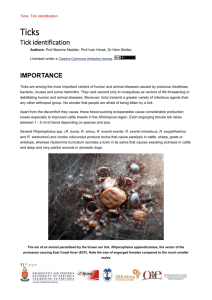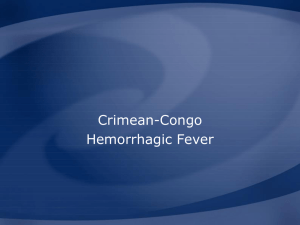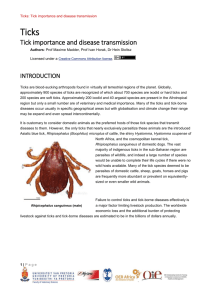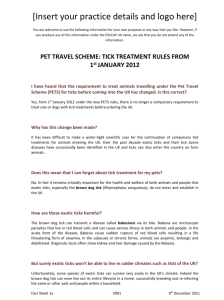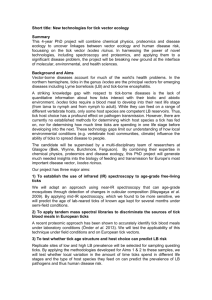Tick Treatment at Home - Southside Place Animal Hospital
advertisement
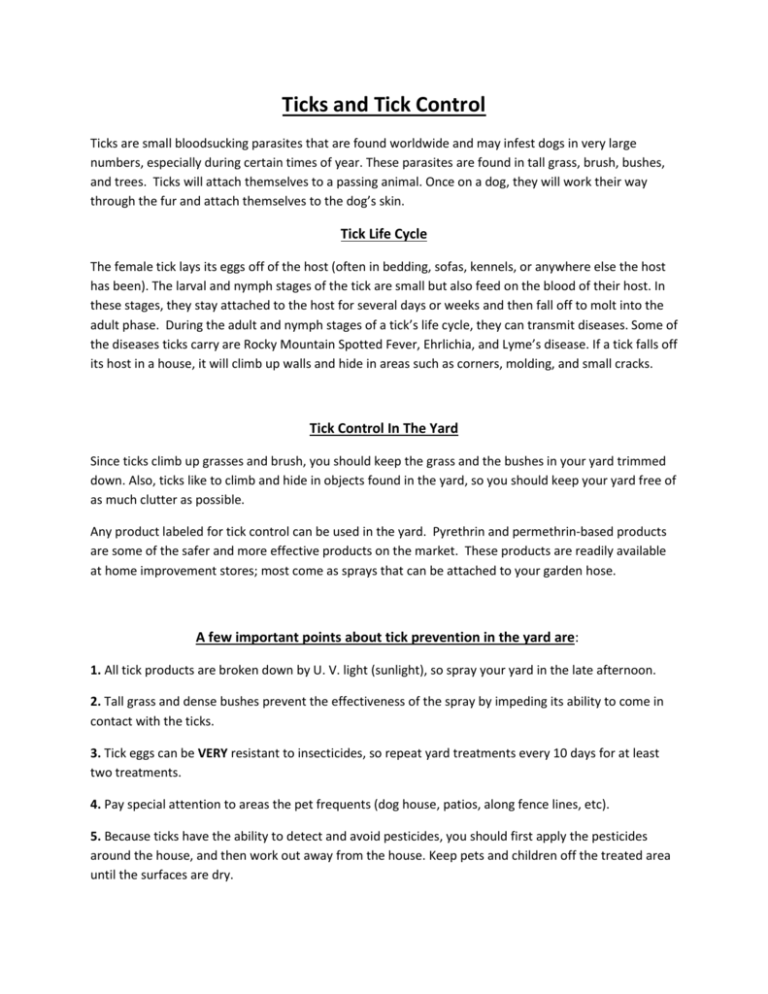
Ticks and Tick Control Ticks are small bloodsucking parasites that are found worldwide and may infest dogs in very large numbers, especially during certain times of year. These parasites are found in tall grass, brush, bushes, and trees. Ticks will attach themselves to a passing animal. Once on a dog, they will work their way through the fur and attach themselves to the dog’s skin. Tick Life Cycle The female tick lays its eggs off of the host (often in bedding, sofas, kennels, or anywhere else the host has been). The larval and nymph stages of the tick are small but also feed on the blood of their host. In these stages, they stay attached to the host for several days or weeks and then fall off to molt into the adult phase. During the adult and nymph stages of a tick’s life cycle, they can transmit diseases. Some of the diseases ticks carry are Rocky Mountain Spotted Fever, Ehrlichia, and Lyme’s disease. If a tick falls off its host in a house, it will climb up walls and hide in areas such as corners, molding, and small cracks. Tick Control In The Yard Since ticks climb up grasses and brush, you should keep the grass and the bushes in your yard trimmed down. Also, ticks like to climb and hide in objects found in the yard, so you should keep your yard free of as much clutter as possible. Any product labeled for tick control can be used in the yard. Pyrethrin and permethrin-based products are some of the safer and more effective products on the market. These products are readily available at home improvement stores; most come as sprays that can be attached to your garden hose. A few important points about tick prevention in the yard are: 1. All tick products are broken down by U. V. light (sunlight), so spray your yard in the late afternoon. 2. Tall grass and dense bushes prevent the effectiveness of the spray by impeding its ability to come in contact with the ticks. 3. Tick eggs can be VERY resistant to insecticides, so repeat yard treatments every 10 days for at least two treatments. 4. Pay special attention to areas the pet frequents (dog house, patios, along fence lines, etc). 5. Because ticks have the ability to detect and avoid pesticides, you should first apply the pesticides around the house, and then work out away from the house. Keep pets and children off the treated area until the surfaces are dry. Home Control Because ticks will climb up walls, hide in furniture, crawl into crevices, and get under carpets, home control is more difficult with ticks than it is with fleas. The best way to get a thorough spread of tick product is to use an aerosol fogger. Again, pyrethrin or permethrin based products are good choices. A few important points of home control are: 1. Turn off your air conditioner before you treat your house. 2. Wash all bedding (pet and human) in hot water. 3. Make sure to lift all sofa cushions and bed skirts to allow product to reach hidden areas. 4. Make sure ALL animals are out of the area that is to be treated. Don’t forget about smaller pets, such as birds, reptiles, fish, and pocket pets. If you have a fish tank that is not easily moved, please call us for instructions. 5. Do not re-enter the room for at least 4 hours. 6. When finished treating the area(s), open windows to ventilate the area, then close them and turn the air conditioner back on. Pet Control 1. Advantix and Certifect are good products and will kill ticks, but they can take up to 2-5 days to take effect. 2. Preventic collars are good for killing most ticks in less than 24 hours and help prevent tick attachment. 3. Be aware that products that are safe for dogs are often times not safe to apply to other species; always be sure that the product(s) you are using are appropriate for your pet. Remember no topical products kill ticks instantly or are 100% effective in repelling ticks, no matter what product you put on your dog, if he/she runs through a tick infested area, there WILL be ticks crawling on the dog when he/she comes back into your house. This doesn’t mean that the products aren’t working; it means that there is an environmental problem that also needs to be addressed.
